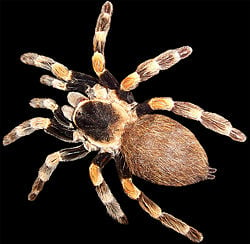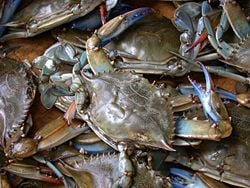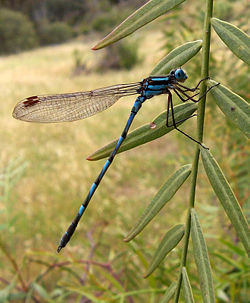Difference between revisions of "Arthropod" - New World Encyclopedia
Rick Swarts (talk | contribs) (Added most recent Wikipedia article) |
|||
| Line 38: | Line 38: | ||
{{Taxobox_end}} | {{Taxobox_end}} | ||
| − | + | {{Taxobox | |
| + | | color = pink | ||
| + | | name = Arthropods | ||
| + | | image = Brachypelma edit.jpg | ||
| + | | image_width = 250px | ||
| + | | image_caption = [[Mexican redknee tarantula]],<br/>''Brachypelma smithi'' | ||
| + | | regnum = [[Animal]]ia | ||
| + | | phylum = '''Arthropoda''' | ||
| + | | phylum_authority = [[Pierre André Latreille|Latreille]], 1829 | ||
| + | | subdivision_ranks = Subphyla and Classes | ||
| + | | subdivision = | ||
| + | *'''Subphylum [[Trilobitomorpha]]''' | ||
| + | **[[Trilobita]] - trilobites (extinct) | ||
| + | *'''Subphylum [[Chelicerata]]''' | ||
| + | **[[Arachnida]] - [[spider]]s, [[scorpion]]s, etc. | ||
| + | **[[Merostomata]] - [[horseshoe crab]]s, etc. | ||
| + | **[[Pycnogonida]] - [[sea spider]]s | ||
| + | *'''Subphylum [[Myriapoda]]''' | ||
| + | **[[Chilopoda]] - [[centipede]]s | ||
| + | **[[Diplopoda]] - [[millipede]]s | ||
| + | **[[Pauropoda]] | ||
| + | **[[Symphyla]] | ||
| + | *'''Subphylum [[Hexapoda]]''' | ||
| + | **[[Insect]]a - insects | ||
| + | **Order [[Diplura]] | ||
| + | **Order [[Collembola]] - springtails | ||
| + | **Order [[Protura]] | ||
| + | *'''Subphylum [[Crustacea]]''' | ||
| + | **[[Branchiopoda]] – [[brine shrimp]] etc. | ||
| + | **[[Remipedia]] | ||
| + | **[[Cephalocarida]] – horseshoe shrimps | ||
| + | **[[Maxillopoda]] - [[barnacle]]s, [[fish louse|fish lice]], etc. | ||
| + | **[[Ostracoda]] – seed shrimp | ||
| + | **[[Malacostraca]] - [[lobster]]s, [[crab]]s, [[shrimp]]s, etc. | ||
| + | }} | ||
| − | '''Arthropods''' ([[Scientific classification| | + | '''Arthropods''' ([[Scientific classification|phylum]] '''Arthropoda''') ([[Greek language|Greek]] for ''jointed feet'') are the largest [[phylum]] of [[animal]]s and include the [[insect]]s, [[arachnid]]s, [[crustacean]]s, and others. Approximately eighty percent of extant (living today) animal species are arthropods, with over a million modern species described and a [[fossil record]] reaching back to the early [[Cambrian]]. Arthropods are common throughout marine, freshwater, terrestrial, and even aerial environments, as well as including various [[symbiosis|symbiotic]] and [[parasite|parasitic]] forms. They range in size from microscopic [[plankton]] (~0.25 [[millimetre|mm]]) up to forms several metres long. |
| − | |||
| − | |||
| − | |||
| − | |||
| − | |||
| − | |||
| + | Arthropods are characterised by the possession of a [[segment]]ed body with [[appendage]]s on each segment. They have a [[dorsal]] heart and a [[ventral]] nervous system. All arthropods are covered by a hard [[exoskeleton]] that is made out of [[chitin]], a [[polysaccharide]]. Periodically, an arthropod sheds this covering when it [[ecdysis|moults]]. This covering makes arthropods less prone to [[dehydration]]. | ||
== Basic arthropod structure == | == Basic arthropod structure == | ||
| − | [[ | + | [[Image:Blue crab on market in Piraeus - Callinectes sapidus Rathbun 20020819-317.jpg|left|thumb|250px|[[Blue crab]], ''Callinectes sapidus'']] |
| − | |||
| − | + | The success of the arthropods is related to their hard '''[[exoskeleton]]''', segmentation, and jointed [[appendage]]s. The appendages are used for feeding, sensory reception, defense, and locomotion. | |
| − | + | Most arthropods respire (breathe) through a [[trachea]]l system (exceptions are [[Pauropoda]], some [[thysanura]]ns and some [[arachnid]]s like many [[mite]]s); a potential difficulty considering that the skeletal structure is external and covers nearly all of the body. [[Aquatic]] arthropods use [[gills]] to exchange gases. These gills have an extensive surface area in contact with the surrounding water. [[Landform|Terrestrial]] arthropods have internal surfaces that are specialised for gas exchange. Insects have tracheal systems: air sacs leading into the body from [[pore]]s, called [[spiracles]], in the epidermis [[cuticle]]. | |
| − | + | Arthropods have an [[Circulatory system#Open circulatory system|open circulatory system]]. [[Circulatory system#Open circulatory system|Haemolymph]], a [[copper]]-based [[blood]] analogue, is propelled by a series of hearts into the body cavity where it comes in direct contact with the tissues. Arthropods are [[protostome]]s. There is a [[body cavity| coelom]], but it is reduced to a tiny cavity around the reproductive and excretory organs, and the dominant body cavity is a hemocoel, filled with hemolymph which bathes the organs directly. The arthropod body is divided into a series of distinct segments, plus a presegmental ''acron'' which usually supports [[compound eyes | compound]] and simple eyes and a postsegmental ''[[telson]]''. These are grouped into distinct, specialised body regions called ''tagmata''. Each segment at least primitively supports a pair of [[appendage]]s. | |
| − | |||
| − | + | The cuticle in arthropods forms a rigid exoskeleton, composed mainly of [[chitin]], which is periodically shed as the animal grows. They contain an inner zone (procuticle) which is made of protein and chitin (a polysaccharide) and is responsible for the strength of the exoskeleton. The outer zone (epicuticle) lies on the surface of the procuticle. It is nonchitinous and is a complex of [[proteins]] and [[lipids]]. It provides the moisture proofing and protection to the procuticle. The exoskeleton takes the form of plates called ''sclerites'' on the segments, plus rings on the appendages that divide them into segments separated by joints. This is in fact what gives arthropods their name—joint feet—and separates them from their very close relatives, the [[Onychophora]] and [[Tardigrada]], also called [[Lobopoda]] (and which is sometimes included in a group called [[Panarthropoda]], that also includes true arthropods). The skeletons of arthropods strengthen them against attack by predators and are impermeable to water. In order to grow, an arthropod must shed its old exoskeleton and secrete a new one. This process, [[moult]]ing, is expensive in terms of energy consumption, and during the moulting period, an arthropod is vulnerable. | |
| − | [[Image:Common_blue_damselfly02.jpg|thumb|right|250px| | + | ==Classification of arthropods== |
| − | + | [[Image:Common_blue_damselfly02.jpg|thumb|right|250px|[[Common Blue Damselfly]] (''Enallagama cyathigerum''), an insect]] | |
| + | Arthropods are typically [[scientific classification|classified]] into five [[subphylum|subphyla]]: | ||
| + | # '''[[Trilobite]]s''' are a group of formerly numerous marine animals that died in the [[extinction event|mass extinction]] at the [[Permian-Triassic extinction event|end of the Permian]]. | ||
| + | # '''[[Chelicerata|Chelicerates]]''' include [[spider]]s, [[mite]]s, [[scorpion]]s and related organisms. They are characterised by the presence of [[chelicerae]]. | ||
| + | # '''[[Myriapoda|Myriapods]]''' comprise [[millipede]]s and [[centipede]]s and their relatives and have many body segments, each bearing one or two pairs of legs. They are sometimes grouped with the hexapods. | ||
| + | # '''[[Hexapoda|Hexapods]]''' comprise [[insect]]s and three small orders of insect-like animals with six thoracic legs. They are sometimes grouped with the myriapods, in a group called [[Uniramia]]. | ||
| + | # '''[[Crustacean]]s''' are primarily marine (a notable exception being [[woodlouse|woodlice]]) and are characterised by having [[biramous]] appendages. They include [[lobster]]s, [[crab]]s, [[barnacle]]s, and many others. | ||
| − | + | Aside from these major groups, there are also a number of fossil forms as [[Cambropodus]], [[Anomalocarida]] and [[Euthycarcinoidea]], mostly from the lower [[Cambrian]], which are difficult to place, either from lack of obvious affinity to any of the main groups or from clear affinity to several of them. | |
| − | + | ==Related groups== | |
| + | [[Image:31-Velvet Worm.JPG|thumb|left|[[Velvet worm]], a member of the Onychophora]] | ||
| + | At one point, it was considered that the different subphyla of arthropods had separate origins from segmented worms, and in particular that the [[Uniramia]] were closer to the [[Onychophora]] than to other arthropods. However, this is rejected by most workers, and is contradicted by genetic studies. | ||
| − | + | Traditionally the [[Annelida]] have been considered the closest relatives of these three phyla, on account of their common segmentation. More recently, however, this has been considered convergent evolution, and the arthropods and allies may be more closely related to certain [[body cavity|pseudocoelomates]] such as [[roundworm]]s that share with them growth by moulting, or [[ecdysis]]. These two possible lineages have been termed the [[Articulata]] and [[Ecdysozoa]]. | |
| − | + | <br clear="all"> | |
| − | |||
| − | |||
| − | |||
| − | |||
| − | |||
| − | |||
== External links and references == | == External links and references == | ||
| − | {{ | + | {{Wikibookspar|Dichotomous Key|Arthropoda}} |
{{commons2|Arthropoda|Arthropoda}} | {{commons2|Arthropoda|Arthropoda}} | ||
| + | *[http://cirrusimage.com/ Common North American Arthropods: 4,000 diagnostic photos, descriptions, taxonomy] | ||
*[http://evolution.berkeley.edu/evolibrary/article/arthropodstory The Arthropod Story] (from [http://evolution.berkeley.edu/ Understanding evolution] @ [http://berkeley.edu/ Berkeley.edu]) | *[http://evolution.berkeley.edu/evolibrary/article/arthropodstory The Arthropod Story] (from [http://evolution.berkeley.edu/ Understanding evolution] @ [http://berkeley.edu/ Berkeley.edu]) | ||
*http://www.itis.usda.gov [[Integrated Taxonomic Information System|ITIS]] TSN: 82696 | *http://www.itis.usda.gov [[Integrated Taxonomic Information System|ITIS]] TSN: 82696 | ||
| + | * [http://bugguide.net/ BugGuide] Photographs, life history information, and identification of North American terrestrial arthropods | ||
*http://www.peripatus.gen.nz/Taxa/Arthropoda/Index.html Campbell, Reece and Mitchell. Biology. 1999 | *http://www.peripatus.gen.nz/Taxa/Arthropoda/Index.html Campbell, Reece and Mitchell. Biology. 1999 | ||
*[http://www.straightdope.com/mailbag/mspiderhydraulic.html Do spiders have hydraulic legs?] (from [[The Straight Dope]]) | *[http://www.straightdope.com/mailbag/mspiderhydraulic.html Do spiders have hydraulic legs?] (from [[The Straight Dope]]) | ||
| + | *[http://www.fossilmall.com/Cambrian_Shadows/euthycarcinoid.htm Euthycarcinoida] | ||
| + | *[http://www.abdn.ac.uk/rhynie/euthy.htm Euthycarcinoids] | ||
| − | + | {{credit|43946002}} | |
| − | |||
| − | {{credit| | ||
[[Category:Life sciences]] | [[Category:Life sciences]] | ||
| + | [[Category: Animals]] | ||
Revision as of 03:36, 17 March 2006
| Arthropods | ||||
|---|---|---|---|---|
 Brachypelma smithi | ||||
| Scientific classification | ||||
| ||||
| Subphyla and Classes | ||||
NOTE: Some classification schemes group |
| Arthropods | ||||
|---|---|---|---|---|
 Mexican redknee tarantula,
Brachypelma smithi | ||||
| Scientific classification | ||||
| ||||
|
Arthropods (phylum Arthropoda) (Greek for jointed feet) are the largest phylum of animals and include the insects, arachnids, crustaceans, and others. Approximately eighty percent of extant (living today) animal species are arthropods, with over a million modern species described and a fossil record reaching back to the early Cambrian. Arthropods are common throughout marine, freshwater, terrestrial, and even aerial environments, as well as including various symbiotic and parasitic forms. They range in size from microscopic plankton (~0.25 mm) up to forms several metres long.
Arthropods are characterised by the possession of a segmented body with appendages on each segment. They have a dorsal heart and a ventral nervous system. All arthropods are covered by a hard exoskeleton that is made out of chitin, a polysaccharide. Periodically, an arthropod sheds this covering when it moults. This covering makes arthropods less prone to dehydration.
Basic arthropod structure
The success of the arthropods is related to their hard exoskeleton, segmentation, and jointed appendages. The appendages are used for feeding, sensory reception, defense, and locomotion.
Most arthropods respire (breathe) through a tracheal system (exceptions are Pauropoda, some thysanurans and some arachnids like many mites); a potential difficulty considering that the skeletal structure is external and covers nearly all of the body. Aquatic arthropods use gills to exchange gases. These gills have an extensive surface area in contact with the surrounding water. Terrestrial arthropods have internal surfaces that are specialised for gas exchange. Insects have tracheal systems: air sacs leading into the body from pores, called spiracles, in the epidermis cuticle.
Arthropods have an open circulatory system. Haemolymph, a copper-based blood analogue, is propelled by a series of hearts into the body cavity where it comes in direct contact with the tissues. Arthropods are protostomes. There is a coelom, but it is reduced to a tiny cavity around the reproductive and excretory organs, and the dominant body cavity is a hemocoel, filled with hemolymph which bathes the organs directly. The arthropod body is divided into a series of distinct segments, plus a presegmental acron which usually supports compound and simple eyes and a postsegmental telson. These are grouped into distinct, specialised body regions called tagmata. Each segment at least primitively supports a pair of appendages.
The cuticle in arthropods forms a rigid exoskeleton, composed mainly of chitin, which is periodically shed as the animal grows. They contain an inner zone (procuticle) which is made of protein and chitin (a polysaccharide) and is responsible for the strength of the exoskeleton. The outer zone (epicuticle) lies on the surface of the procuticle. It is nonchitinous and is a complex of proteins and lipids. It provides the moisture proofing and protection to the procuticle. The exoskeleton takes the form of plates called sclerites on the segments, plus rings on the appendages that divide them into segments separated by joints. This is in fact what gives arthropods their name—joint feet—and separates them from their very close relatives, the Onychophora and Tardigrada, also called Lobopoda (and which is sometimes included in a group called Panarthropoda, that also includes true arthropods). The skeletons of arthropods strengthen them against attack by predators and are impermeable to water. In order to grow, an arthropod must shed its old exoskeleton and secrete a new one. This process, moulting, is expensive in terms of energy consumption, and during the moulting period, an arthropod is vulnerable.
Classification of arthropods
Arthropods are typically classified into five subphyla:
- Trilobites are a group of formerly numerous marine animals that died in the mass extinction at the end of the Permian.
- Chelicerates include spiders, mites, scorpions and related organisms. They are characterised by the presence of chelicerae.
- Myriapods comprise millipedes and centipedes and their relatives and have many body segments, each bearing one or two pairs of legs. They are sometimes grouped with the hexapods.
- Hexapods comprise insects and three small orders of insect-like animals with six thoracic legs. They are sometimes grouped with the myriapods, in a group called Uniramia.
- Crustaceans are primarily marine (a notable exception being woodlice) and are characterised by having biramous appendages. They include lobsters, crabs, barnacles, and many others.
Aside from these major groups, there are also a number of fossil forms as Cambropodus, Anomalocarida and Euthycarcinoidea, mostly from the lower Cambrian, which are difficult to place, either from lack of obvious affinity to any of the main groups or from clear affinity to several of them.
Related groups
At one point, it was considered that the different subphyla of arthropods had separate origins from segmented worms, and in particular that the Uniramia were closer to the Onychophora than to other arthropods. However, this is rejected by most workers, and is contradicted by genetic studies.
Traditionally the Annelida have been considered the closest relatives of these three phyla, on account of their common segmentation. More recently, however, this has been considered convergent evolution, and the arthropods and allies may be more closely related to certain pseudocoelomates such as roundworms that share with them growth by moulting, or ecdysis. These two possible lineages have been termed the Articulata and Ecdysozoa.
External links and references
- Common North American Arthropods: 4,000 diagnostic photos, descriptions, taxonomy
- The Arthropod Story (from Understanding evolution @ Berkeley.edu)
- http://www.itis.usda.gov ITIS TSN: 82696
- BugGuide Photographs, life history information, and identification of North American terrestrial arthropods
- http://www.peripatus.gen.nz/Taxa/Arthropoda/Index.html Campbell, Reece and Mitchell. Biology. 1999
- Do spiders have hydraulic legs? (from The Straight Dope)
- Euthycarcinoida
- Euthycarcinoids
Credits
New World Encyclopedia writers and editors rewrote and completed the Wikipedia article in accordance with New World Encyclopedia standards. This article abides by terms of the Creative Commons CC-by-sa 3.0 License (CC-by-sa), which may be used and disseminated with proper attribution. Credit is due under the terms of this license that can reference both the New World Encyclopedia contributors and the selfless volunteer contributors of the Wikimedia Foundation. To cite this article click here for a list of acceptable citing formats.The history of earlier contributions by wikipedians is accessible to researchers here:
The history of this article since it was imported to New World Encyclopedia:
Note: Some restrictions may apply to use of individual images which are separately licensed.



